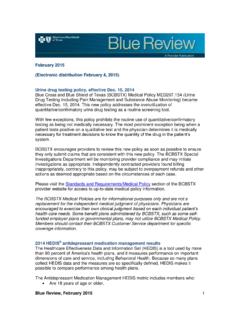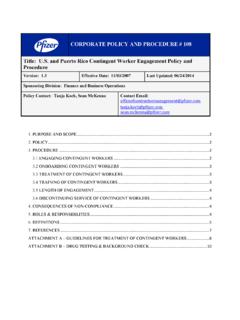Transcription of WHO Drug Information
1 Pre-publication draft - page numbers are not for citation purposes 1 WHO drug Information Vol. 30, No. 1, 2016 ContentsConcept paper for comment3 A framework for risk-based identification of essential medicine products for local manufacturing in low- and middle-income countriesSafety of medicines24 The WHO Collaborating Centre for International drug Monitoring29 Look-alike sound-alike drug name confusion: trastuzumab emtansineQuality of medicines35 Quality of misoprostol productsPrequalification40 WHO rotational fellowships: an updateSafety news46 RestrictionsNicorandil: Use only as second-line angina treatment;Fosamprenavir: contraindicated with paritaprevir.
2 Ombitasvir / paritaprevir / ritonavir: extended contraindication;Erlotinib: only for certain types of non-small cell lung cancer;47 Safety warningsThalidomide: reduced starting dose in patients over 75 years;Nintedanib: avoid in hepatic function disorder;Lenvatinib: tumour haemorrhage;Biphosphonates: very rare osteonecrosis of external ear canal ;Atovaquone: agranulocytosis and leukopenia;48 Known risksSGLT-2 inhibitors: ketoacidosis and urinary tract infections;Elvitegravir/cobicistat/emtri citabine/tenofovir: interactions with anticonvulsants;Nivolumab: diabetes mellitus and ketoacidosis ;Natalizumab: new measures to manage PML;Fingolimod: new measures to minimize PML and BCC risks;Methylphenidate: hepatic failure;Varenicline: psychiatric symptoms and potential alcohol interaction;51 Label changes Posaconazole: dosing of oral formulations not interchangeable;Rosiglitazone: Risk Evaluation and Mitigation Strategy eliminated;51 Unchanged recommendationsRivaroxaban: clinical trial conclusions maintained;52 Safety reviews52 Medicines qualityPharmaceuticals from Tianjin City region: potential contamination; ;Baclofen active pharmaceutical ingredient: potential contamination.
3 Notice of concern for Cadila Healthcare Ltd 54 Falsified product alertsPhenobarbitone; Yellow fever vaccines; Hepatitis C medicinesRegulatory news56 Medicines regulationNew biosimilar regulations in Australia ;EMA launches PRIME scheme for medicines targeting unmet needs ;EMA guidance for industry on clinical studies and clinical data publication;EMA increases access to reports on adverse reactions ;Safety features on packaging to be introduced in Europe57 International Health RegulationsPoliovirus spread: continued public health emergency;Zika virus disease a public health emergency58 Blood safetyFDA updates blood donor deferral policies 59 ApprovedSebelipase alfa: for lysosomal acid lipase (LAL) deficiency; Selexipag: for pulmonary arterial hypertension; Albutrepenonacog alfa: for Haemophilia B ; Recombinant von Willebrand factor: for control of bleeding episodes; Emtricitabine / tenofovir alafenamide: for HIV infection; Emtricitabine / rilpivirine / tenofovir alafenamide: for HIV infection; Elbasvir / grazoprevir: for hepatitis C virus (HCV) infection; Uridine triacetate: for emergency treatment of chemotherapy overdose.
4 Elotuzumab: for multiple myeloma; Alectinib: for certain advanced non-small cell lung cancers ; Lesinurad: for hyperuricaemia; Brivaracetam: for epilepsy;61 Follow-on biological productInsulin glargine 62 Extensions of indicationsNivolumab: for kidney cancer; Eribulin: for liposarcoma;Publications and events63 DevelopmentWHO report on health development goals63 Access to health productsMPP signs licensing agreements ;Call for applications for the 2017 WHO Model EML and EMLc;Impact factor of key medicines ;Making medicines in Africa;WHO to fast-track availability of Zika diagnostics65 DiseasesTop emerging pathogens;Ebola: transmission chains stopped but new flare-ups likely ;Malaria: more countries moving towards elimination;Rabies: new global framework launched;66 AntibioticsIndustry declaration on combating antimicrobial resistance Consultation documents67 The International Pharmacopoeia67 Misoprostol ContinuedWHO drug Information WHO drug Information Vol.
5 30, No. 1, 20162 Pre-publication draft - page numbers are not for citation purposes72 Misoprostol dispersion76 Misoprostol tablets79 Carbamazepine84 Carbamazepine tablets87 Carbamazepine chewable tablets90 Carbamazepine oral suspension International Nonproprietary Names (INN)93 Recommended INN: List 75 ContinuedAbbreviations and web sitesCHMP Committee for Medicinal Products for Human Use (EMA)EMA European Medicines Agency ( )EU European UnionFDA Food and drug Administration ( )Health Canada Federal department responsible for health product regulation in Canada ( )MHLW Ministry of Health, Labour and Welfare, JapanMHRA Medicines and Healthcare Products Regulatory Agency, United Kingdom ( )Medsafe New Zealand Medicines and Medical Devices Safety Authority ( )PRAC Pharmacovigilance Risk Assessment Committee (EMA)PMDA Pharmaceuticals and Medical Devices Agency, Japan ( )
6 Swissmedic Swiss Agency for Therapeutic Products ( )TGA Therapeutic Goods Administration, Australia ( ) United States of America Note:The online version of this issue (available at ) has direct clickable hyperlinks to the documents and web pages Conference of drug Regulatory Authorities (ICDRA)The 17th ICDRA will take place inCape Town, South Africa 27 November 2 December 2016 Pre-publication draft - page numbers are not for citation purposes 3 WHO drug Information Vol. 30, No. 1, 2016 Concept paper for commentA framework for risk-based identification of essential medicine products for local manufacturing in low- and middle-income countriesThis is the first draft of a concept paper for discussion.
7 It aims to provide a risk assessment strategy and aspects to consider when evaluating whether an essential medicine can be manufactured locally in low- and middle-income countries with relatively limited pharmaceutical manufacturing capability and concept paper is part of the work that WHO is initiating, in collaboration with UNIDO, to promote quality local production of medicines in developing countries. The paper is intended to be developed into a joint document which provides guidance to manufacturers, regulatory officials and policy makers on how to minimize risk in manufacturing operations by selecting appropriate essential medicines for production in accordance with existing levels of GMP compliance, and how to tailor technical assistance to implement this approach, with the ultimate goal to eventually achieve local production of medicines by fully GMP-compliant manufacturers in developing countries.
8 A second concept paper on Good Manufacturing Practice (GMP) road mapping is being prepared by UNIDO and will also be published in this journal for and suggestions on this paper are invited to facilitate further discussion. They should be sent to Introduction BackgroundA number of papers have been published that discuss the manufacturing of medicinal products in low- and middle-income countries (LMICs) in various contexts. These include the diseases to be treated, capacity building, access to medicines, cost, skills, training, job creation, intellectual property rights, transfer of technology, government incentives, and advantages and disadvantages ( 1, 2, 3, 4, 5).
9 At the African Union Conference of Ministers of Health, held in Johannesburg in April 2007 (6), a Pharmaceutical Manufacturing Plan for Africa was proposed: This plan of action is being presented in phases to allow intense assessment of the feasibility and modality of local manufacturing of medicines in Africa. The paper further suggested that the plan must investigate and suggest criteria for determining what is to be produced. One of the conclusions of this proposal stated: Local production can be successfully done in the continent. However, there is need for the African countries to reassess the realities, possibilities and the feasibility of the programme so that it moves from being a political slogan to a reality after good ground work.
10 The time needed to do thorough scientific analyses in the continent, together with WHO and other bodies that can add value, is certainly longer than two years. Often an assessment of what is to be produced focuses on the diseases to be treated, with little attention to the level of technology involved with respect to the development and manufacture of pharmaceutical products in LMICs. The technology level does not only Concept paper for comment WHO drug Information Vol. 30, No. 1, 20164 Pre-publication draft - page numbers are not for citation purposesaffect the feasibility of the manufacturing process, including packaging and quality control testing , but also the overall quality assurance system of the manufacturer, as well as the capacity of the local national medicines regulatory authority (NMRA) to effectively assess the resultant dossier, to conduct inspections and to regulate life cycle variations.


















